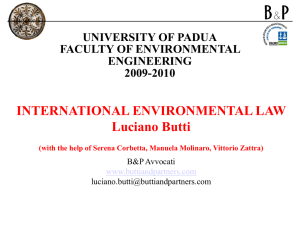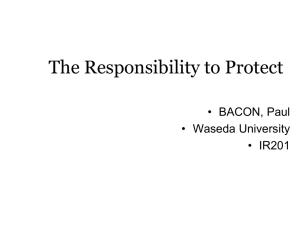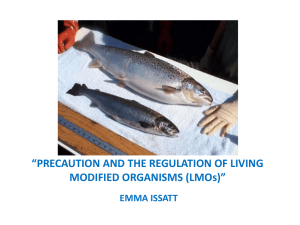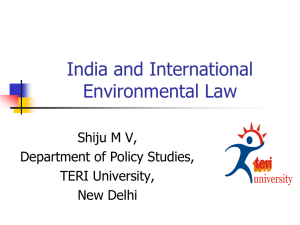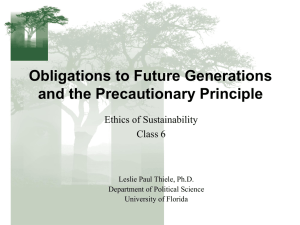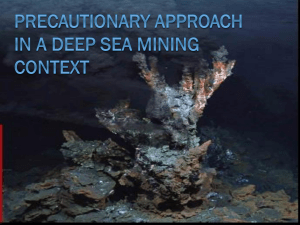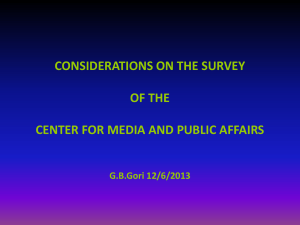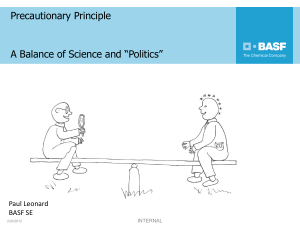PP ILaw AC - circuitdebater
advertisement
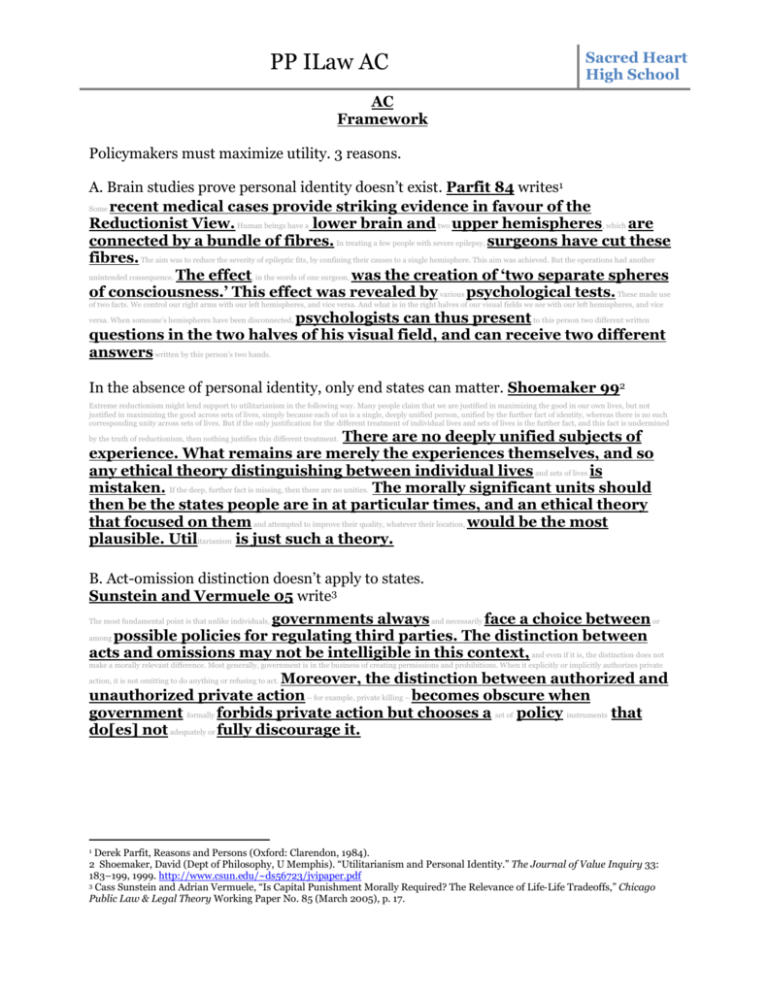
PP ILaw AC Sacred Heart High School AC Framework Policymakers must maximize utility. 3 reasons. A. Brain studies prove personal identity doesn’t exist. Parfit 84 writes1 Some recent medical cases provide striking evidence in favour of the Reductionist View. Human beings have a lower brain and two upper hemispheres, which are connected by a bundle of fibres. In treating a few people with severe epilepsy, surgeons have cut these fibres. The aim was to reduce the severity of epileptic fits, by confining their causes to a single hemisphere. This aim was achieved. But the operations had another unintended consequence. The effect, in the words of one surgeon, was the creation of ‘two separate spheres of consciousness.’ This effect was revealed by various psychological tests. These made use of two facts. We control our right arms with our left hemispheres, and vice versa. And what is in the right halves of our visual fields we see with our left hemispheres, and vice psychologists can thus present to this person two different written questions in the two halves of his visual field, and can receive two different answers written by this person’s two hands. versa. When someone’s hemispheres have been disconnected, In the absence of personal identity, only end states can matter. Shoemaker 992 Extreme reductionism might lend support to utilitarianism in the following way. Many people claim that we are justified in maximizing the good in our own lives, but not justified in maximizing the good across sets of lives, simply because each of us is a single, deeply unified person, unified by the further fact of identity, whereas there is no such corresponding unity across sets of lives. But if the only justification for the different treatment of individual lives and sets of lives is the further fact, and this fact is undermined There are no deeply unified subjects of experience. What remains are merely the experiences themselves, and so any ethical theory distinguishing between individual lives and sets of lives is mistaken. If the deep, further fact is missing, then there are no unities. The morally significant units should then be the states people are in at particular times, and an ethical theory that focused on them and attempted to improve their quality, whatever their location, would be the most plausible. Utilitarianism is just such a theory. by the truth of reductionism, then nothing justifies this different treatment. B. Act-omission distinction doesn’t apply to states. Sunstein and Vermuele 05 write3 governments always and necessarily face a choice between or possible policies for regulating third parties. The distinction between acts and omissions may not be intelligible in this context, and even if it is, the distinction does not The most fundamental point is that unlike individuals, among make a morally relevant difference. Most generally, government is in the business of creating permissions and prohibitions. When it explicitly or implicitly authorizes private Moreover, the distinction between authorized and unauthorized private action – for example, private killing – becomes obscure when government formally forbids private action but chooses a set of policy instruments that do[es] not adequately or fully discourage it. action, it is not omitting to do anything or refusing to act. Derek Parfit, Reasons and Persons (Oxford: Clarendon, 1984). 2 Shoemaker, David (Dept of Philosophy, U Memphis). “Utilitarianism and Personal Identity.” The Journal of Value Inquiry 33: 183–199, 1999. http://www.csun.edu/~ds56723/jvipaper.pdf 3 Cass Sunstein and Adrian Vermuele, “Is Capital Punishment Morally Required? The Relevance of Life‐Life Tradeoffs,” Chicago Public Law & Legal Theory Working Paper No. 85 (March 2005), p. 17. 1 PP ILaw AC Sacred Heart High School C. The ultimate human good is happiness. Darwish 094 Let’s start with knowledge. It is clear that those who value knowledge for its own sake (for instance, highly motivated professionals) find pleasure in both the pursuit and attainment of knowledge, however exhausted they become in either case. So, granted that knowledge, for them, is a value that has intrinsic worth in itself, and is thus sought for itself, [because] it is a value that yields their pleasure or happiness. The same can be said about the other values. Let’s take autonomy in the sense expressed by Hooker as “control over one’s own life” as another example. Here one needs to say no more than that the mere fact that people seek autonomy explains the satisfaction or the pleasure autonomy brings. Those who value autonomy, thus seek it for itself, cannot feel happy when their decisions are not in their hands, or when they do not have control over their own life. In short, they cannot be happy otherwise. Moore, who explicitly differs from the classical utilitarians in holding that pleasure is not the sole good, 20 says that “the most valuable things… are pleasures of human intercourse and the enjoyment of beautiful objects,” 21 which seems to mean that such things are valued for the pleasures and the enjoyment they bring. These examples clearly show that though these values have intrinsic worth, they bring or constitute our pleasure. However, rule util is the best decision procedure for maximizing utility. Direct util calc is messy and leads to inaccurate decisions. Rules are more reliable. Chappell 55 gives 6 warrants Utilitarianism is a much maligned moral theory, in part because it's so easily abused. It's easy for people to misunderstand the theory, and use it, for example, to argue for totalitarianism. But of course utilitarianism properly understood recommends no such thing. In fact, it tends to support our common-sense moral intuitions. Strange as it may utilitarianism says that we ought to do whatever would maximize utility. But attempting to reason in a utilitarian fashion tends to have disastrous consequences, and fails miserably to maximize utility. Therefore, we ought not to reason in a utilitarian manner. Instead, we should try to inculcate those dispositions and attitudes, and abide by those principles, that would tend to promote utility. That is, we should be honest, compassionate, loyal, trustworthy, averse to harming others, partial towards loved ones, and so forth. We should, in other words, be virtuous rather than scheming. J.L. Mackie (p.91) offers [There are] six utilitarian reasons for opposing "the direct use of utilitarian calculation as a practical working morality": 1. Shortage of time and energy will in general preclude such calculations. 2. Even if time and energy are available, the relevant information commonly is not. 3. An agent's judgment on particular issues is likely to be distorted by his own interests and special affections. 4. Even if he were intellectually able to determine the right choice, weakness of will would be likely to impair his putting of it into effect. 5. Even decisions that are right in themselves and actions based on them are liable to be misused as precedents, so that they will encourage and seem to legitimate wrong actions that are superficially similar to them. 6. And, human nature being what it is, a practical working morality must not be too demanding: it is worse than useless to set standards so high that there is no real chance that actions seem, utilitarianism recommends that we do not base our everyday moral decision-making on calculations of utility. Why is this? Well, will even approximate “Rethinking Utilitarianism,” Bahaa Darwish (Qatar University). Teaching Ethics 10 (1):87-109 (2009). http://www.uvu.edu/ethics/seac/Darwish%20-%20Rethinking%20Utilitarianism.pdf 5 Chappell 05 (Richard, PhD in Philosophy from Princeton, Philosophy, Et Cetera, http://www.philosophyetc.net/2005/06/indirect-utilitarianism.html) 4 PP ILaw AC Sacred Heart High School And, our strongest internal convictions justify adhering to general rules. Hooker 8 writes6 On the other hand, some moral judgments seem virtually impossible to deny. One is that torturing people for fun is wrong. Another is that the fact that an act would mak[ing]e an innocent person suffer counts morally against it, that is, counts towards the act’s being morally wrong. These and other convictions of about the same level of specificity seem so secure that any moral theory had better agree with them. No moral theory seizes our confidence to the extent that we would be willing to take that theory’s side in a fight against such convictions. So, how well do rule-consequentialism’s implications match our convictions? We have convictions that there are negative moral duties not to physically harm others, not to steal, not to break promises, positive moral duties to aid family and friends with one’s own resources, and weaker positive duties to help strangers, including those who will never be in a position to reciprocate. Let us crudely divide these into two groups: prohibitions on action, and duties to murder, torture, promisebreaking, and so on can be wrong even when they result in somewhat more good than not doing them would. The rule-consequentialist reason for this is that the [as] general internalization of a code prohibiting murder, torture, promise-breaking, and so on [them] would clearly result in more good than general internalization of a code with no prohibitions on such acts. aid. Rule-[util] consequentialism claims that individual acts of We should accept our strong intuitions as non-inferentially justified. Parfit 10 writes7 We may not be able to prove that our normative epistemic beliefs are not illusions. We may also be unable to prove that [or] we are not brains in a vat, or being deceived by some demon. But if we claim less than absolute certainty, we can justifiably reject such skeptical views. In arguing that we can know some normative epistemic truths, we must appeal to some of these truths. We must claim that we have reasons to believe that we can respond to reasons. Such Any justification must end somewhere. Justifications of beliefs can best end with intrinsic credibilities and decisive epistemic reasons. We do not have to show that we have further reasons to believe that we have these reasons, and further reasons to believe that we have these further reasons, and so on for ever. Some beliefs seem indubitable, and we seem to have decisive reasons to accept many other beliefs. Nor do we arguments are in one way circular, but that does not make them fail. seem to have any strong reason to doubt that we do have such reasons. Given these facts, if we can understand how it might be true that we are responding to such reasons, we can justifiably believe that we are responding to such reasons. We can justifiably believe that there are some truths about what we ought to believe, and that we know some of these truths. Following ILaw is a utility-maximizing rule. 4 reasons. [Omitted] Thus the standard is consistency with international law. Ignore permissibility and presumption because moral uncertainty means we’ll always have a non-zero credence in the existence of morality, so there’s always a risk of offense in favor of one action. 6 “Right, Wrong, and Rule Consequentialism,” Brad Hooker. 2008 7 Derek Parfit, On What Matters (draft: July 10, 2010), 697. PP ILaw AC Sacred Heart High School Advocacy I advocate that developing countries should accept the Precautionary Principle on resource extraction issues. I reserve the right to clarify. The PP is key to solving environmental harms. We can’t afford to wait for scientific certainty. SEHN 98 writes8 What is the precautionary principle? A comprehensive definition of the precautionary principle was spelled out in a January 1998 meeting of scientists, lawyers, policy makers The Wingspread Statement on the Precautionary Principle, summarizes the principle this way: "When an activity raises threats of harm to the environment or human health, precautionary measures should be taken even if some cause and effect relationships are not fully established scientifically." Key elements of the principle include taking precaution in the face of scientific uncertainty; exploring alternatives to possibly harmful actions; and environmentalists at Wingspread, headquarters of the Johnson Foundation in Racine, Wisconsin. placing the burden of proof on proponents of an activity rather than on victims or potential victims of the activity; and using democratic processes to carry out and enforce the principle - including the public right to informed consent. Is there some special meaning for "precaution"? It's the common sense idea behind many adages: "Be careful." "Better safe than sorry." "Look before you leap." "First do no harm." What about "scientific uncertainty"? Why should we take action before science tells us what is harmful or what is Sometimes if we wait for proof it is too late causing harm? . Scientific standards for demonstrating cause and effect are very high. For example, smoking was strongly suspected of causing lung cancer long before the link was demonstrated conclusively - that is, to the satisfaction of scientific standards of cause and effect. By then, many smokers had died of lung cancer. But many other people had already quit smoking because of the growing evidence that smoking Often a problem - such as a cluster of cancer is too large, its causes too diverse, or the effects too long term to be sorted out with scientific experiments that would prove cause and effect. It's hard to take these problems into the laboratory. Instead, we have to rely on observations, case studies or predictions based on current knowledge. According to the precautionary principle, when substantial scientific evidence of any kind gives us good reason to believe that an activity, technology or substance may be harmful, we should act to prevent harm. If we always wait for scientific certainty, people may suffer and die, and damage to the natural world may be irreversible. We have lots of environmental regulations. Aren't we already exercising was linked to lung cancer. These people were wisely exercising precaution despite some scientific uncertainty. cases or global warming - precaution? In some cases, to some extent, yes. When federal money is to be used in a major project, such as building a road on forested land or developing federal waste programs, the planners must produce an "environmental impact statement" to show how it will affect the surroundings. Then the public has a right to help determine whether the study has been thorough and all the alternatives considered. That is a precautionary action. But most environmental regulations, such as the Clean Air Act, the Clean Water Act and the Superfund Law, are aimed at cleaning up pollution and controlling the amount of it released into the environment. They regulate toxic substances as they are emitted rather than limiting their use or production in the first place. These laws have served an important purpose - they have given us cleaner air, water and land. But they are based on the assumption that humans and ecosystems can absorb a certain amount of contamination without being harmed. We are now learning how difficult it is to know what levels of contamination, if any, are safe. Many of our food and drug laws and practices are more precautionary. Before a drug is introduced into the marketplace, the manufacturer must demonstrate that it is safe and effective. Then people must be told about risks and side effects before they use it. But there are some major loopholes in our regulations. If the precautionary principle were universally applied, many toxic substances, contaminants, and unsafe practices would not be produced or used in the first place. The precautionary principle concentrates on prevention rather than cure. How would the precautionary principle change that without bringing the economy to a halt? It would encourage the exploration of alternatives - better, safer, cheaper ways to do things- and the development of "cleaner" products and technologies. Sometimes simply slowing down in order to learn more about potential harm is the best alternative. It would shift the burden of proof from the public to proponents of a technology. The principle would ensure that the public knows about and has a say in the deployment of technologies that may be hazardous. Proponents would have to demonstrate through an open process that a technology was safe or necessary and that no better alternatives were available. Science and Environmental Health Network. “The Precautionary Principle: A Fact Sheet.” March 1998. http://www.sehn.org/Volume_3-1.html 8 PP ILaw AC Sacred Heart High School The PP solves econ collapse by promoting sustainable resource management. Raffensperger 4 writes9 If you start with the premise that the foundation of an economy is capital, then you're going to do everything you can to protect capital. You'll see the differences in taxation -- in the United States, for example, we tax labor much more than capital and interest on capital, because we don't value labor very much. It's capital that is the big economic driver. it is really our common resources -- the air, the water, the street in front of my house, the library, the public schools, the national parks, the public health (not my individual health, but public health) -- that is the generative ground of the economy. Without clean air, without clean water, without the ocean front, without all of those other things that I mentioned, the economy would collapse . Without the roads, for example, we couldn't move our farm products to market. So the commons and the common resources are the basis of the economy, the foundation of America and they must be protected. That's one view. I believe by contrast that Carolyn Raffensperger (the founding executive director of the Science and Environmental Health Network. An environmental lawyer, she specializes in the fundamental changes in law and policy necessary for the protection and restoration of public health and the environment. Raffensperger is co-editor of Protecting Public Health and the Environment: Implementing the Precautionary Principle, the most comprehensive exploration to date of the history, theory and implementation of the Precautionary Principle)> 9 PP ILaw AC Sacred Heart High School Contention I contend that ILaw requires the PP. The PP is supported by multiple international treaties. Tickner et al. 99 writes10 the P P in International Treaties Ozone Layer Protocol Uses of recautionary rinciple and Agreements Parties to this protocol . . . determined to protect the ozone layer by taking precautionary measures to control equitably total global emissions of substances that deplete it, with the ultimate objective of their elimination on the basis of developments in scientific knowledge, taking into account technical and economic considerations. . . . Protocol on Second North Sea Declaration Substances that Deplete the Ozone Layer, Sept. 16, 1987, 26 ILM 1541 In order to protect the North Sea from possibly damaging effects of the most dangerous substances...a precautionary approach is addressed which may require action to control inputs of such substances even before a causal link has been established by absolutely clear scientific evidence. Ministerial Declaration Calling for Reduction of Pollution, Nov. 25, 1987, 27 ILM 835. United Nations Environment Programme Recommends that all Governments adopt "the principle of precautionary action" as the basis of their policy with regard to the prevention and elimination of marine pollution. Report of the Governing Council on the Work of its Fifteenth Session, Nordic Council's Conference And taking into account....the need for an effective precautionary approach, with that important principle intended to safeguard the marine United Nations Environment Programme, UN GAOR, 44th Sess. Supp No 25, 12th mtg at 153, UN DOC A44/25 (1989). ecosystem by, among other things, eliminating and preventing pollution emissions where there is reason to believe that damage or harmful effects are likely to be caused, even where there is inadequate or inconclusive scientific evidence to prove a causal link between emissions and effects. Nordic Council's International Conference on Pollution of the Seas: Final Document Agreed to Oct. 18, 1989, in Nordic Action Plan on Pollution of the Seas, 99 app. V (1990) PARCOM Recommendation 89/1 - 22 June, 1989 The the Paris Convention Contracting Parties to for the Prevention of Marine Pollution from Land-Based Sources: Accept the principle of safeguarding the marine ecosystem of the Paris Convention area by reducing at source polluting emissions of substances that are persistent, toxic, and liable to bioaccumulate by the use of the best available technology and other appropriate measures. This applies especially when there is reason to assume that certain damage or harmful effects on the living resources of the sea are likely to be caused by such substances, even where there is no scientific evidence to prove a causal link between emissions and effects (the principle of Third North Sea Conference precautionary action). The participants...will continue to apply the precautionary principle, that is to take action to avoid potentially damaging impacts of substances that are persistent, toxic, and liable to bioaccumulate even where there is no scientific evidence to prove a causal link between emissions and effects Final Declaration of the Third International Conference on Protection of the North Sea, Mar. 7-8, 1990. 1 YB Int'l Envtl Law 658, 662-73 (1990). Bergen Declaration on Sustainable Development In order to achieve sustainable development, policies must be based on the precautionary principle. Environmental measures must anticipate, prevent, and attack the causes of environmental degradation. Where there are threats of serious or irreversible damage, lack of full scientific certainty should not be used as a reason for postponing measures to prevent environmental degradation. Bergen Ministerial Second World Climate Conference In order to achieve sustainable development in all countries and to meet the needs of present and future generations, Declaration on Sustainable Development in the ECE Region. UN Doc. A/CONF.151/PC/10 (1990), 1 YB Intl Envtl Law 429, 4312 (1990) precautionary measures to meet the climate challenge must anticipate, prevent, attack or minimize the causes of, and mitigate the adverse consequences of, environmental degradation that might result from climate change. Where there are threats of serious of irreversible damage, lack of full scientific certainty should not be used as a reasons for postponing cost-effective measures to prevent such environmental degradation. The measure adopted should take into account different socioeconomic contexts. Ministerial Declaration of the Second World Climate Conference (1990). 1 YB Intl Envtl Law 473, 475 (1990) Bamako Convention on Transboundary Waste in Africa Hazardous to Each Party shall strive to adopt and implement the preventive, precautionary approach to pollution problems which entails, inter alia, preventing the release into the environment of substances which may cause harm to humans or the environment without waiting for scientific proof regarding such harm. The Parties shall cooperate with each other in taking appropriate measures to implement the precautionary principle to pollution prevention through the application of clean production methods, rather than the pursuit of a permissible emissions approach based on assimilative capacity assumptions. Bamako Convention on Hazardous Wastes within Africa, Jan. 30, 1991, art. 4, 30 ILM 773. OECD Council Recommendation The Recommendation is accompanied by Guidance which is an integral part of the Recommendation. It lists some essential policy aspects including: the absence of complete information should not preclude precautionary action to mitigate the risk of significant harm to the environment. OECD Council Recommendation C(90)164 on Integrated Pollution Prevention and Control - January 1991 Maastricht Treaty on the European Union Community policy on the environment...shall be based on the precautionary principle and on the principles that preventive actions should be taken, that environmental damage should as a priority be rectified at source and that the polluter should pay. Treaty on the European Union, Sept. 21, 1994, 31 ILM 247, 285-86. Helsinki Convention on the Protection and Use of Transboundary Watercourses and International Lakes The precautionary principle, by virtue of which action to avoid the potential transboundary impact of the release of hazardous substances shall not be postponed on the ground that scientific research has not fully proved a causal link between those Convention on the Protection and Use of Transboundary Watercourses and International Lakes, Mar. 17, 1992, 31 ILM 1312. The Rio Declaration on substances, on the one hand, and the potential transboundary impact, on the other hand. Environment and Development In order to protect the environment, the precautionary approach shall be widely applied by States according to their capabilities. Where there are threats of serious or irreversible damage, lack of full scientific certainty shall not be used as a reason for postponing cost-effective measures to prevent environmental degradation. Rio Declaration on Environment and Development, June 14, 1992, 31 ILM 874. Climate Change Conference The parties should take precautionary measures to anticipate, prevent, or minimize the causes of climate change and mitigate its adverse effects. Where there are threats of serious or irreversible damage, lack of full scientific certainty should not be used as a reason for postponing such measures, taking into account that policies and measures to deal with climate change should be cost-effective so as to ensure global benefits at the lowest possible cost. To achieve this, such policies and measures should take into account different socioeconomic contexts, be comprehensive, cover all relevant sources, sinks and reservoirs of greenhouse gases and adaptation, and comprise all economic sectors. Efforts to address climate change may be carried out cooperatively by interested parties. Framework Convention on Climate Change, May 9, 1992, 31 ILM 849. UNCED Text on Ocean Protection A precautionary and anticipatory rather than a reactive approach is necessary to prevent the degradation of the marine environment. This requires inter alia, the adoption of precautionary measures, environment impact assessments, clean production techniques, recycling, waste audits and minimization,, construction and/or improvement of sewage treatment facilities, quality management criteria for the proper handling of hazardous substances, and a comprehensive approach to damaging impacts from air, land, and water. Any management framework must include the improvement of coastal human settlements and the integrated management and development of coastal areas. UNCED Text on Protection of Oceans. UN GAOR, 4th Sess., UN Doct A/CONF.151/PC/100 Add. 21 (1991) Energy Charter Treaty In pursuit of sustainable development and taking into account its obligations under those international agreements concerning the environment to which it is a party, each Contracting Party shall strive to minimize in an economically efficient manner harmful Environmental Impact occurring either within or outside its Area from all operations within the Energy Cycle within its Area, taking proper account of safety. In doing so each Contracting Party shall act in a Cost-Effective manner. In its policies and actions each Contracting Party shall strive to take precautionary measures to prevent or minimize Environmental Degradation. The Contracting Parties agree that the polluter in the Areas of Contracting Parties, should, in principle, bear the cost of pollution, including transboundary pollution, with due regard to the public interest and without distorting investment in the Energy Cycle or International Trade. The Draft European Energy Charter Treaty Annex I, Sept 14, 1994, 27/94 CONF/104. U.S. President's Council on Sustainable Development There are certain beliefs that we as Council members share that underlie all of our agreements. We believe: (number 12) even in the face of scientific uncertainty, society should take reasonable actions to avert risks where the potential harm to human health or the environment is thought to be serious or irreparable. President's Council on Sustainable Development. Sustainable America: A New Consensus, 1996 Joel Tickner (Lowell Center for Sustainable Production), Carolyn Raffensperger and Nancy Meyers (SEHN). “The precautionary principle in action: A handbook.” Science and Environmental Health Network. 1999. 10 PP ILaw AC Sacred Heart High School Resource extraction kills biodiversity. EPA 5 writes11 resource extraction, along with other human activities, increases the rate at which species of plants and animals are now vanishing. Diminishing the Earth’s biodiversity has a substantial human cost because wild species and natural ecosystems are important resources. For example, some economists estimate that the lost pharmaceutical value from In addition to the benefits already discussed, using recovered resources reduces threats to biodiversity. Natural plant species extinctions in the United States alone is almost $12 billion. Reducing the land disturbance and pollution associated with virgin materials extraction by using recovered materials, therefore, helps stop the degradation of the Earth’s ecosystems. Renewable Versus Nonrenewable Resources Some natural resources are nonrenewable and some are renewable. Nonrenewable resources are those that become depleted more quickly than they naturally regenerate. One example of a nonrenewable resource is mineral ore. Once mined and used completely, it is gone forever for all practical purposes, because it will take millions of years to regenerate. Renewable resources can be replenished at approximately the same rate at which they are used (for example, sun and wind, which can be used to provide energy). What are the Benefits of Natural Resources? Renewable resources offer a number of environmental and economic benefits over nonrenewable resources. One obvious benefit is the infinite supply of renewable resources—they cannot be depleted. Another benefit of using renewable resources is self-reliance. A country that can provide its own renewable resource, such as solar-powered electricity, need not rely on other countries for an energy source. Additionally, renewable resources offer communities relief during periods of recovery from natural disasters. When communities lose standard services that require the use of natural resources (e.g., electric power or natural gas), renewable resources, such as wind and solar energy systems, are used to provide these services until the usual methods of achieving service can be restored. Following Hurricane Andrew in 1992, for example, a south-Miami subdivision continued to have working streetlights because they were all photovoltaic (PV)-powered. The areas became neighborhood gathering spots for a community left without electricity following the storm. In several cases, homes equipped with PV systems were able to keep minimal services running and became emergency shelters for surrounding residents who had lots power. What Are the Challenges of Using Natural Resources? Extracting, processing, and using natural resources creates air, water, and land pollution, which can cause global environmental problems. For example, carbon dioxide, which is produced from deforestation, and from burning coal, oil, and natural gas (fossil fuels), is a critical greenhouse gas. Many scientists believe that the buildup of greenhouse gases in the atmosphere can cause global climate change. Over time, this condition could pose serious dangers extracting and using resources can disturb relationships within ecosystems. For example, the effects of clearing on old-growth forest for wood can destroy habitats used by many animals, forcing them to find homes elsewhere. If these animals leave an ecosystem, further disturbances can occur within plant and animal populations that depend on these species. around the world, prompting such disasters as flooding, drought, and disease. In addition, ILaw requires reducing biodiversity loss. Glennon 9012 international law requires states to take appropriate steps to protect endangered species. Customary norms are created by state practice "followed by them from a sense of legal obligation." 250 Like highly codified humanitarian law norms that have come to bind even states that are not parties to the instruments promulgating them, 251 wildlife protection norms also have become binding on nonparties as customary law. Closely related to this process of norm creation by practice is that of norm creation by convention: customary norms are created by international agreements "when such agreements are intended for adherence by states generally and are in fact widely accepted." 252 Several It is now possible to conclude that customary such [*31] agreements are directed at wildlife protection, 253 and CITES is one of them. It is intended for adherence by states generally 254 and is accepted by the 103 states that have become parties. In addition, some nonparties comply with certain CITES documentary requirements so as to trade with parties. 255 CITES is not "rejected by a significant number of states"; 256 only the United Arab Emirates has withdrawn from the agreement. In such circumstances, the International Court of Justice has observed, international agreements constitute state practice and represent law for nonparties. 257 Moreover, customary norms are created by "the general principles of law recognized by civilized nations." 258 Because CITES requires domestic implementation by parties to it, 259 and because the overall level of compliance seems quite high, 260 the general principles embodied in states' domestic endangered species laws may be relied upon as another source of customary law. 261 Even apart from the CITES requirements, states that lack laws protecting endangered species seem now to be the clear exception rather than the rule. 262 That there exists opinio juris as to the binding character of this obligation 263 is suggested by the firm support given endangered species [*32] protection by the UN General Assembly and various international conferences. 264 US Environmental Protection Agency. “The Quest for Less: A Teacher’s Guide to Reducing, Reusing and Recycling.” 2005 edition. http://www.epa.gov/osw/education/quest/pdfs/unit1/chap1/u1_natresources.pdf 12 Michael Glennon, Board of Editors @ American Journal of Intl Law, Jan 1990, 84 A.J.I.L. 1 11 PP ILaw AC Sacred Heart High School Every violation of I-Law matters. It sets a precedent for future decisions. Calabresi 05 writes13 Six Justices on the Rehnquist Court signed on to the conclusion in Roper that the Court may, at least on some occasions, rely upon foreign sources of law. We submit, therefore, that such reliance is not likely to wane anytime soon, even with two new appointments, and that the real question for the future is not whether but when the Court will cite reliance upon such [foreign] sources of law has a selfvalidating and snowballing aspect to it, wherein the more significant and widespread the Court's use of foreign sources now, the greater the body of precedent the Court will have to cite for using foreign sources of law in the future. foreign sources of law. This is especially true since 13 Steven Calabresi, professor of law at Northwestern, and Stephanie Zimdahl, law clerk, 47 Wm and Mary L. Rev. 743, “THE SUPREME COURT AND FOREIGN SOURCES OF LAW: TWO HUNDRED YEARS OF PRACTICE AND THE JUVENILE DEATH PENALTY DECISION”, December 2005, lexis PP ILaw AC Sacred Heart High School Next is theory preempts 1. Err aff on theory. Neg won 53% of available prelims and elims at Lexington according to Joy of Tournaments. This also means presume aff if presumption matters. 2. Neg burden is to defend a competitive post-fiat policy. Offense-defense is key to fairness and real world education. This means ignore skepticism. Nelson 8 writes14 the truth-statement model of the resolution imposes an absolute burden of proof on the affirmative: if the resolution is a truth-claim, and the affirmative has the burden of proving that claim, in so far as intuitively we tend to disbelieve truthclaims until And we are persuaded otherwise, the affirmative has the burden to prove that statement absolutely true. Indeed, one of the most common theory arguments in LD is conditionality, which argues it is inappropriate for the affirmative to claim only proving the truth of part of the resolution is sufficient to earn the ballot. Such a model of the resolution also gives the negative access to a range of strategies that many students, coaches, and judges find ridiculous or even irrelevant to evaluation of the resolution. negative need only prevent the affirmative from proving the truth of the resolution, it is logically sufficient to negate to deny our ability to make truth-statements or to prove normative morality does not exist or to deny If the the reliability of human senses or reason. Yet, even though most coaches appear to endorse the truth-statement model of the resolution, they complain about the use of such such strategies seem fundamentally unfair, as they provide the negative with functionally infinite ground, as there are a nearly infinite variety of such skeptical negative strategies, even though they are a necessary consequence of that model. And, moreover, objections to normative claims, while continuing to bind the affirmative to a much smaller range of options: advocacy of the resolution as a whole. Instead, it seems much more reasonable to treat the resolution as a way to equitably divide ground: the affirmative advocating the desirability of a world in which people adhere to the value judgment implied by the resolution and the negative advocating the desirability of a world in which people adhere to a value judgment mutually exclusive to that [Under] competing world-views rather than of truth, the affirmative gains access to increased flexibility regarding how he or she chooses to defend that world, while the negative retains equal flexibility while being denied access to those skeptical arguments indicted above. Our ability to make normative implied by the resolution. By making the issue one of desirability of claims is irrelevant to a discussion of the desirability of making two such claims. Unless there is some significant harm in making such statements, some offensive reason to reject making them that can be avoided by an advocacy mutually exclusive with that of the affirmative such objections are not a reason the negative world is more desirable, and therefore not a reason to negate. Note this is precisely how things have been done in policy debate for some time: a team that runs a kritik is expected to offer some impact of the mindset they are indicting and some alternative that would solve for that impact. A team that simply argued some universal, unavoidable, problem was bad and therefore a reason to negate would not be very successful. It is about time LD started treating such arguments the same way. Such a model of the resolution has additional benefits as well. First, it forces both debaters to offer offensive reasons to prefer their worldview, thereby further enforcing a parallel burden structure. This means debaters can no longer get away with arguing the resolution is by definition true of false. The “truth” of the particular vocabulary of the resolution is irrelevant to its desirability. Second, it is intuitive. When people evaluate the truth of ethical claims, they consider their implications in the real world. They ask themselves whether a world in which people live by that ethical rule is better than one in which they don’t. Such debates don’t happen solely in the abstract. We want to know how the various options affect us and the world we live in. 3. The neg must defend one unconditional advocacy. Conditionality is bad because it makes the neg a moving target which kills 1AR strategy. He’ll kick it if I cover it and extend it if I undercover it, meaning I have no strategic options. Also, it’s unreciprocal because I can’t kick the AC. 14 Adam F. Nelson, J.D.1. Towards a Comprehensive Theory of Lincoln-Douglas Debate. 2008. PP ILaw AC Sacred Heart High School 4. Case outweighs theory. Students’ analyzing environmental issues is critical for sustainable solutions. This must be coupled with policy advocacy to succeed. Cotgrave and Alkhaddar 615 Environmental education Many writers have determined that the main aim of environmental education is to change attitudes, that will in turn change behaviour. As long ago as 1976, Ramsey and Rickson identified that it has long been known that the basis for many environmental problems is irresponsible behaviour. Without a doubt, one of the most important influences on behaviour is attitude, that in turn is influenced by education. Campbell Bradley et al. (1999) stress the need for trying to change young people’s environmental attitudes because young people As future policymakers, the youth of today will be responsible for ‘fixing’ the environment and they will be the ones who must be persuaded to act now in order to avoid paying a high price to repair damage to the ultimately will be affected by, and will need to provide, solutions to environmental problems arising from present day actions. environment in the future, if indeed it is repairable. Therefore it appears that effective environmental education, which changes the attitudes of young people, is crucial. The as education seeks to lead opinion, it will do so more effectively if it keeps in mind the distinctive nature of its mission, which is first and foremost to improve its students’ understanding. Their concern may well be awakened as a result; but it must be a (then) Department for Education (DFE) report, commonly known as the ‘Toyne Report’ (DFE, 1993), concluded that properly informed concern. This does not necessarily mean treating the environment as a purely scientific issue, but does mean that the respective roles of science and ethics need to be distinguished, and the complexities of each need to be acknowledged. Failure to do this may lead all too readily to an ‘environmentalism’ which, by depicting possibilities as certainties, can only discredit itself in the long run and feed the complacency which it seeks to dispel. McKeown-Ice and Dendinger (2000) have identified the fact that scientific knowledge and political intervention will not solve the environmental problem on their own, thus implying that something additional is required to change behaviour. As has already been discussed, behaviour changes can only occur if attitudes change and this can be achieved through education. As Fien (1997) identifies, environmental education can play a key role by creating awareness, and changing people’s values, skills and behaviour. Introducing environmental elements into the curriculum can therefore be seen as a potentially effective way of transferring knowledge. This should in turn improve attitudes that will lead to improvements in environmental behaviour. Graham (2000) believes that it is crucial that building professionals not only participate in the creation of projects that have low environmental impact, but equally it is There are however limitations as to what education can achieve on its own , for as Jucker (2002) believes, if we do not do everything we can to transform our political, economic and social systems into more sustainable structures, we might as well forget the educational part. important that they learn to conceive, nurture, promote and facilitate the kind of paradigm changes seen as necessary to create a sustainable society. 5. Gutcheck against dumb theory. Competing interps leads to a race to the bottom where every round comes down to theory, killing substantive education. Intervention is inevitable in blippy theory debates. 6. Prefer aff interpretations. Key to clash. O’Donnell 4 writes16 AFC preserves the value of the first affirmative constructive speech. This speech is the starting point for the debate. It is a function of necessity. The debate must begin somewhere if it is to begin at all. Failure to grant AFC is a denial of the service rendered by the affirmative team’s labor when they crafted this speech. Further, if the affirmative does not get to pick the starting point, [renders] the opening speech act is essentially rendered meaningless while the rest of the debate becomes a debate about what we should be debating about. Alison Cotgrave has a PhD in Sustainability Literacy, she is currently the Deputy Director of the School of the Built Environment and a researcher in construction education, she is also a Fellow of the Higher Education Academy, Rafid Alkhaddar has a PhD in Civil Engineering and currently teaches at the School of the Built Environment John Moores University in Liverpool as a Professor of Water and Environmental Engineering (March 2006, “Greening the Curricula within Construction Programmes,” Journal for Education in the Built Environment, Vol.1, Issue 1, March 2006 pp. 3-29, http://131.251.248.49/jebe/pdf/AlisonCotgrave1(1).pdf 16 Timothy M. O’Donnell (Director of Debate University of Mary Washington) “And the Twain Shall Meet: Affirmative Framework 15 Choice and the Future of Debate” 2004.
